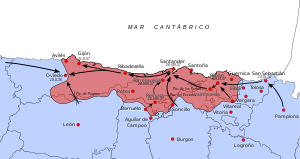Asturias Offensive
| Asturias Offensive | |||||||||
|---|---|---|---|---|---|---|---|---|---|
| Part of the Spanish Civil War | |||||||||
 | |||||||||
| |||||||||
| Belligerents | |||||||||
|
Isaac Puente Battalion |
| ||||||||
| Commanders and leaders | |||||||||
|
|
José Solchaga | ||||||||
| Strength | |||||||||
|
45,000 180 artillery guns 1 destroyer 1 submarine |
90,000 250 artillery guns 250 aircraft 2 cruisers 1 destroyer | ||||||||
You can help expand this article with text translated from the corresponding article in Spanish. (July 2011) Click [show] for important translation instructions.
|
The Asturias Offensive (
Background
After the failed Republican
Opposing forces
The Nationalist offensive was launched by General Dávila's Army of the North, with 80,000 men. This force included José Solchaga's four Brigades of Navarre, Aranda's three divisions and the Italian CTV. The Nationalists also had 250 cannons and 250 aircraft.[2]
Opposing them, the Republicans had the Army of the North, led by Colonel Prada, with the XIV Army Corps led by Francisco Galán (8,000–10,000 men) and Colonel Linares's XVII Army corps (35,000). Prada's chief of staff was Francisco Ciutat. The Republicans had 180 cannons,[3] one squadron of Chatos and two flights of Moscas, around 35 aircraft.[4]
The Nationalist Offensive

The Nationalist offensive started on 1 September, with Solchaga advancing from the East and Aranda from the southwest, but despite their crushing numerical and air superiority their advance was painfully slow (less than a kilometre a day). The Republicans fought fiercely, and the difficult terrain of the
The main goal of the Republicans was to delay the Nationalist advance until winter came. Nevertheless, the
The Republican government then ordered a general evacuation.
Aftermath
The Nationalist reprisals were harsh. In Oviedo alone, 1,000 republican prisoners were shot.[11] The Republican prisoners were sent to labour battalions or were forced to join the Nationalist army (around 100,000).[12] Furthermore, with the conquest of the North, the Nationalists now controlled 36 per cent of Spanish industrial production, 60 per cent of the coal, and all of the steel-production.[13]
See also
- List of Spanish Nationalist military equipment of the Spanish Civil War
- List of weapons of the Corpo Truppe Volontarie
- Condor Legion
- List of Spanish Republican military equipment of the Spanish Civil War
Notes
- ^ Beevor, Antony. (2006). The Battle for Spain. The Spanish Civil War, 1936–1939. Penguin Books. p. 301
- ^ Beevor, Antony. (2006). The Battle for Spain. The Spanish Civil War, 1936–1939. Penguin Books. p. 301.
- ^ Thomas, Hugh. (2001). The Spanish Civil War. Penguin Books. London. p. 707
- ^ Beevor, Antony. (2006). The Battle for Spain. The Spanish Civil War, 1936–1939. Penguin Books. p. 301.
- ^ "El Mazuco (The impossible defence)".
- ^ Beevor, Antony. (2006). The Battle for Spain. The Spanish Civil War, 1936–1939. Penguin Books. p. 302
- ^ Beevor, Antony. (2006). The Battle for Spain. The Spanish Civil War, 1936–1939. Penguin Books. London. p. 302
- ^ Thomas, Hugh. (2001). The Spanish Civil War. Penguin Books. London. p.708
- ^ Beevor, Antony. (2006). The Battle for Spain. The Spanish Civil War, 1936–1939. Penguin Books. London. p. 302
- ^ Thomas, Hugh. (2001). The Spanish Civil War. Penguin Books. London. pp.708–710
- ^ Thomas, Hugh. (2001). The Spanish Civil War. Penguin Books. London. p. 710
- ^ Beevor, Antony. (2006). The Battle for Spain. The Spanish Civil War, 1936–1939. Penguin Books. London. pp. 302-303.
- ^ Thomas, Hugh. (2001). The Spanish Civil War. Penguin Books. London. p. 712
Bibliography
- Beevor, Antony (2006). The Battle for Spain The Spanish Civil War, 1936-1939. Penguin. ISBN 978-0-14-303765-1.
- Thomas, Hugh (2003). The Spanish Civil War. Penguin Books, Limited (UK). ISBN 978-0-14-101161-5.
